 Bibs were hastily donned to soak up the undignified rivers of drooling dribble that appeared in the office when Panasonic first announced the latest addition to their high quality Lumix digital camera range, the LX1, back in July.
Bibs were hastily donned to soak up the undignified rivers of drooling dribble that appeared in the office when Panasonic first announced the latest addition to their high quality Lumix digital camera range, the LX1, back in July.
It wasn’t just the stunning looks, manual control, image stabilisation and crisp wide-angle 4X Leica zoom lens that set our saliva organs into ungainly overdrive – we loved the fact that this was the first camera to feature a 16:9 aspect ratio, using the full 8.4-megapixel sensor.
The 16:9 aspect ratio closely approximates the natural wide field of view of the human eye meaning its dimensions will fill a widescreen TV perfectly.
 The camera can also shoot in 3:2 and the more conventional 4:3 aspect ratio, with a switch on the lens barrel making it easy to switch to the format best suited for the composition on a shot-by-shot basis.
The camera can also shoot in 3:2 and the more conventional 4:3 aspect ratio, with a switch on the lens barrel making it easy to switch to the format best suited for the composition on a shot-by-shot basis.
Boasting an impressively wide zoom range of 28 mm to 112 mm (35mm equiv), the LEICA DC VARIO-ELMARIT lens should prove ideal for indoor photography, architectural and landscape shots.
Recovering alcoholics and compulsive wobblers will love the optical stabilization system (OIS) that does a great job of steadying the camera at slow shutter speeds and producing sharp images where other cameras would fail.
 It’s no mean feat to fit an effective stabilisation system into a 4.2 by 2.2 by 1.4 inches camera, and users should find it an invaluable feature for low light photography – small cameras can be notoriously hard to hold steady at slow shutter speeds.
It’s no mean feat to fit an effective stabilisation system into a 4.2 by 2.2 by 1.4 inches camera, and users should find it an invaluable feature for low light photography – small cameras can be notoriously hard to hold steady at slow shutter speeds.
As well as a comprehensive selection of 14 scene modes, there’s manual controls offering a choice of apertures between f/2.8 and f/8 (adjustable in 1/3-stop increments) at the wide-angle position and f/4.9 to f/8 at the telephoto end.
Shutter speeds can be selected from 8 seconds to 1/2,000 second (60 seconds to 1/2,000 second in manual mode).
 Sensitivity can be set to ISO 80, 100, 200, or 400, with the built in pop-up flash offering coverage up to 13.1 feet in wide-angle mode and 7.5 feet at the telephoto position.
Sensitivity can be set to ISO 80, 100, 200, or 400, with the built in pop-up flash offering coverage up to 13.1 feet in wide-angle mode and 7.5 feet at the telephoto position.
Photo enthusiasts will appreciate the manual focus feature which uses a joystick to fine-tune focus on an enlarged portion of the image, with the same joystick being used to change shutter speed and aperture in manual or shutter/aperture priority mode.
In line with its high end aspirations, images can be saved in JPEG (choice of two compression ratios), TIFF and raw file formats.
 The Leica lens can focus down to two inches in macro modem with focus switchable from spot to single-point, three-point, or nine-point autofocus zones.
The Leica lens can focus down to two inches in macro modem with focus switchable from spot to single-point, three-point, or nine-point autofocus zones.
For manual and automatic shooting, there’s evaluative, centre-weighted and spot metering available.
Wannabe Spielberg’s will be tempted by the camera’s particularly impressive movie mode, offering an astonishing ultra-high-quality 16:19 Wide VGA film-clip capability, capturing 848×480 sound movies at a smooth 30fps.
Sadly, there’s no optical viewfinder on offer, so all framing and viewing of images – and camera fine tuning – is taken care of via the a sharp and bright 207k 2.5-inch LCD on the back panel.
 In shooting mode, this presents a wealth of optional information including a handy alignment grid dividing the screen into vertical and horizontal thirds.
In shooting mode, this presents a wealth of optional information including a handy alignment grid dividing the screen into vertical and horizontal thirds.
With its beautiful looks, enthusiast pleasing feature set, world’s first 16:9 aspect ratio and pin-sharp Leica lens, Panasonic look to be on to an absolute winner here – but where is the thing?
Apart from a few, quickly scooped-up, silver versions of the camera appearing online and in central London, most stores are reporting that they are “awaiting stock”, with no news of the drop-dead gorgeous black version that we’re keen to get our paws on.
A few reviews have cropped up on the web – usually in strange languages – with the excellent DPreview.com offering some pre-production samples that looked mighty fine to our eyes
Worryingly, a promised review on dcresource.com has been “delayed due to technical difficulties” – or, as the author explains elsewhere – because the camera “kicked the bucket.”
We hope that that these problems are just pre-production glitches because we’ve rarely seen such a tempting looking camera.
As soon as we get our hands on one, we’ll have a review for you. Soon, we hope!
Lumix LX1
 The UK production and development community is in danger of losing out to competition from overseas if it doesn’t wake up to the potential of mobile TV, said Mark Selby, Nokia’s Global Vice President for Multimedia, (pictured right) at the inaugural Mobile TV forum in London today.
The UK production and development community is in danger of losing out to competition from overseas if it doesn’t wake up to the potential of mobile TV, said Mark Selby, Nokia’s Global Vice President for Multimedia, (pictured right) at the inaugural Mobile TV forum in London today. But many claimed that the lack of spectrum is holding DVB-H back in the UK.
But many claimed that the lack of spectrum is holding DVB-H back in the UK. Digital One owns the UK’s only nationwide commercial DAB multiplex – but the capacity allocated for DMB is minimal.
Digital One owns the UK’s only nationwide commercial DAB multiplex – but the capacity allocated for DMB is minimal.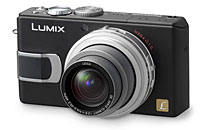 Bibs were hastily donned to soak up the undignified rivers of drooling dribble that appeared in the office when Panasonic first announced the latest addition to their high quality Lumix digital camera range, the LX1, back in July.
Bibs were hastily donned to soak up the undignified rivers of drooling dribble that appeared in the office when Panasonic first announced the latest addition to their high quality Lumix digital camera range, the LX1, back in July. The camera can also shoot in 3:2 and the more conventional 4:3 aspect ratio, with a switch on the lens barrel making it easy to switch to the format best suited for the composition on a shot-by-shot basis.
The camera can also shoot in 3:2 and the more conventional 4:3 aspect ratio, with a switch on the lens barrel making it easy to switch to the format best suited for the composition on a shot-by-shot basis. It’s no mean feat to fit an effective stabilisation system into a 4.2 by 2.2 by 1.4 inches camera, and users should find it an invaluable feature for low light photography – small cameras can be notoriously hard to hold steady at slow shutter speeds.
It’s no mean feat to fit an effective stabilisation system into a 4.2 by 2.2 by 1.4 inches camera, and users should find it an invaluable feature for low light photography – small cameras can be notoriously hard to hold steady at slow shutter speeds.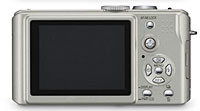 Sensitivity can be set to ISO 80, 100, 200, or 400, with the built in pop-up flash offering coverage up to 13.1 feet in wide-angle mode and 7.5 feet at the telephoto position.
Sensitivity can be set to ISO 80, 100, 200, or 400, with the built in pop-up flash offering coverage up to 13.1 feet in wide-angle mode and 7.5 feet at the telephoto position. The Leica lens can focus down to two inches in macro modem with focus switchable from spot to single-point, three-point, or nine-point autofocus zones.
The Leica lens can focus down to two inches in macro modem with focus switchable from spot to single-point, three-point, or nine-point autofocus zones.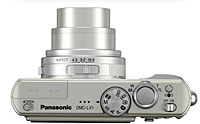 In shooting mode, this presents a wealth of optional information including a handy alignment grid dividing the screen into vertical and horizontal thirds.
In shooting mode, this presents a wealth of optional information including a handy alignment grid dividing the screen into vertical and horizontal thirds.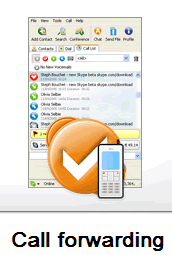 Skype has today announced a new version of their Windows release of Skype.For the first time, several more functions are added to make Skype both a more serious communication tool, and at the same time, more frivolous.First the serious side. v1.4, which has been in beta since August, includes call forwarding for when you aren’t sitting by your computer, or if you’re a little more advanced, you’ve dropped out of WiFi range on your handheld version. If Skype finds you unreachable, you can set it to forward your calls to up to three landlines, or mobiles. The forwarding for the person initiating the call is free, with the Skype user paying for the privilege from their SkypeOut minutes.We see the Real Excitement is around the ability to forward calls from one Skype ID to another, giving the ability to have more than one Skype ID. Until now this had to be handled by all sorts of complexity of running two versions, separate from each other. Calls forwarded to another Skype ID are free.What the significance of the whole of Call Forwarding? Your SkypeIn number, or Skype ID becomes your first point of contact, something we’ve seen before with Unified Messaging (UM). UM didn’t set the world alight when it came to techy attention 2-3 years ago, but Skype has timed this perfectly, realising that people are now ready.
Skype has today announced a new version of their Windows release of Skype.For the first time, several more functions are added to make Skype both a more serious communication tool, and at the same time, more frivolous.First the serious side. v1.4, which has been in beta since August, includes call forwarding for when you aren’t sitting by your computer, or if you’re a little more advanced, you’ve dropped out of WiFi range on your handheld version. If Skype finds you unreachable, you can set it to forward your calls to up to three landlines, or mobiles. The forwarding for the person initiating the call is free, with the Skype user paying for the privilege from their SkypeOut minutes.We see the Real Excitement is around the ability to forward calls from one Skype ID to another, giving the ability to have more than one Skype ID. Until now this had to be handled by all sorts of complexity of running two versions, separate from each other. Calls forwarded to another Skype ID are free.What the significance of the whole of Call Forwarding? Your SkypeIn number, or Skype ID becomes your first point of contact, something we’ve seen before with Unified Messaging (UM). UM didn’t set the world alight when it came to techy attention 2-3 years ago, but Skype has timed this perfectly, realising that people are now ready. Personalisation
Personalisation SanDisk have unveiled their “fingernail-sized” new TrustedFlash cards, a technology that embeds Digital Rights Management (DRM) and decryption technology into memory cards, and also includes a subscription manager enabling the cards to be used for digital subscription music services.
SanDisk have unveiled their “fingernail-sized” new TrustedFlash cards, a technology that embeds Digital Rights Management (DRM) and decryption technology into memory cards, and also includes a subscription manager enabling the cards to be used for digital subscription music services. Harar stated that the TrustedFlash card would act like current SD cards, with the technology able to be extend into on-demand content such as feature films and online games.
Harar stated that the TrustedFlash card would act like current SD cards, with the technology able to be extend into on-demand content such as feature films and online games. BT will roll out IPTV in ‘late summer 2006’, according to Andrew Burke, CEO, BT Entertainment, (pictured right) speaking at the Enhanced TV Show in London today.
BT will roll out IPTV in ‘late summer 2006’, according to Andrew Burke, CEO, BT Entertainment, (pictured right) speaking at the Enhanced TV Show in London today. Elena Branet, Senior Marketing Manager at Microsoft TV, (pictured left) said IPTV would allow viewers to use picture in picture channel surfing, see caller ID on their TV sets, or watch TV while messaging a virtual community of friends and family. She said that basic IPTV would be possible with a minimum connection speed of just 1.5 MB.
Elena Branet, Senior Marketing Manager at Microsoft TV, (pictured left) said IPTV would allow viewers to use picture in picture channel surfing, see caller ID on their TV sets, or watch TV while messaging a virtual community of friends and family. She said that basic IPTV would be possible with a minimum connection speed of just 1.5 MB. Also at the show, David Bainbridge, MD of Yes, Yoo Media, (pictured right) said trials of a new product, ‘Broadband TV’ would start on ntl in October. Not to be confused with IPTV, this is a solution to help content creators repurpose content across platforms – working with cable TV, IPTV and 3.
Also at the show, David Bainbridge, MD of Yes, Yoo Media, (pictured right) said trials of a new product, ‘Broadband TV’ would start on ntl in October. Not to be confused with IPTV, this is a solution to help content creators repurpose content across platforms – working with cable TV, IPTV and 3.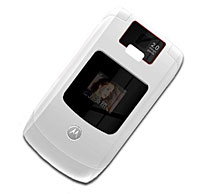 Motorola have offered more details about their forthcoming 3G RAZR V3x slim flip phone.
Motorola have offered more details about their forthcoming 3G RAZR V3x slim flip phone.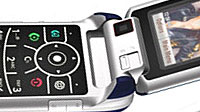 The onboard Bluetooth chip supports wireless stereo sound through Motorola’s Bluetooth Stereo headphones and other compatible hands free wotsits, with up to 512 MB of removable optional TransFlash memory.
The onboard Bluetooth chip supports wireless stereo sound through Motorola’s Bluetooth Stereo headphones and other compatible hands free wotsits, with up to 512 MB of removable optional TransFlash memory.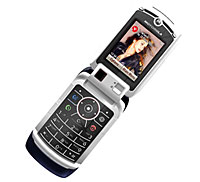 Motorola have also included an advanced speaker-independent voice recognition which lets users state a number/name and be connected without all that pre-recording palaver.
Motorola have also included an advanced speaker-independent voice recognition which lets users state a number/name and be connected without all that pre-recording palaver.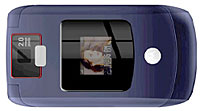 Meanwhile, as Motorola’s phones scoff the pies, rival NEC has launched the
Meanwhile, as Motorola’s phones scoff the pies, rival NEC has launched the 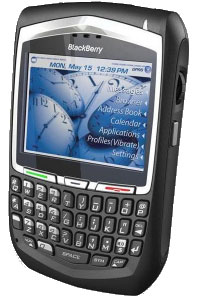 We’re still waiting for the official announcement, but Blackberry enthusiast site Pimstack has managed to unearth some photos and specs of the forthcoming Blackberry 8700.
We’re still waiting for the official announcement, but Blackberry enthusiast site Pimstack has managed to unearth some photos and specs of the forthcoming Blackberry 8700.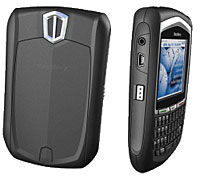 Connectivity is taken care of via quadband GSM/GPRS/EDGE connectivity with onboard support for Bluetooth 2.0. There’s also a hands-free speaker phone built in.
Connectivity is taken care of via quadband GSM/GPRS/EDGE connectivity with onboard support for Bluetooth 2.0. There’s also a hands-free speaker phone built in.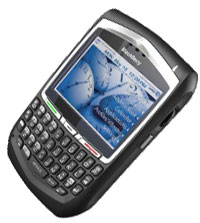 RIM Announce Intel Partnership
RIM Announce Intel Partnership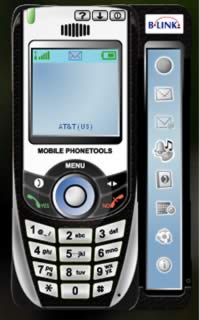 If you’ve ever spent hours shouting at the little blinking blue light on your laptop screaming, “what do you mean you can’t find my phone? IT’S THERE!!”, then you may find Broadcom’s new BLINK Bluetooth software (Bluetooth-Link = BLINK, getit?) bringing your blood pressure down.
If you’ve ever spent hours shouting at the little blinking blue light on your laptop screaming, “what do you mean you can’t find my phone? IT’S THERE!!”, then you may find Broadcom’s new BLINK Bluetooth software (Bluetooth-Link = BLINK, getit?) bringing your blood pressure down.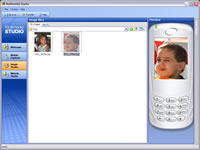 BLINK software claims to soothe the troubled brows of baffled Bluetooth uses with an intuitive graphical user interface (GUI) that makes complex Bluetooth-related tasks “as simple as browsing the Internet.”
BLINK software claims to soothe the troubled brows of baffled Bluetooth uses with an intuitive graphical user interface (GUI) that makes complex Bluetooth-related tasks “as simple as browsing the Internet.” Once fired up, the BLINK software serves up a graphical representation of the user’s mobile phone on their desktop or notebook PC screens.
Once fired up, the BLINK software serves up a graphical representation of the user’s mobile phone on their desktop or notebook PC screens.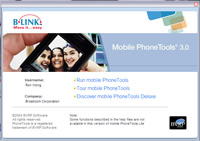 “Digital photos, phone numbers and calendar appointments are literally trapped inside users’ cell phones because of the complexity involved in transferring this information to PCs and other devices,” said Brian O’Rourke, Senior Analyst at In-Stat.
“Digital photos, phone numbers and calendar appointments are literally trapped inside users’ cell phones because of the complexity involved in transferring this information to PCs and other devices,” said Brian O’Rourke, Senior Analyst at In-Stat.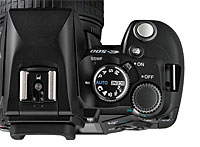 Competition at the lower end of the dSLR market looks set to heat up as Olympus launch their new Four Thirds System digital SLR, the E-500 (called the ‘Olympus EVOLT E-500’ in North America).
Competition at the lower end of the dSLR market looks set to heat up as Olympus launch their new Four Thirds System digital SLR, the E-500 (called the ‘Olympus EVOLT E-500’ in North America).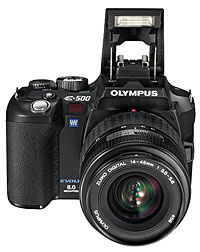 Dominating the back of the camera is a large, 2.5″ HyperCrystal 215k LCD monitor offering a wide viewing angle.
Dominating the back of the camera is a large, 2.5″ HyperCrystal 215k LCD monitor offering a wide viewing angle.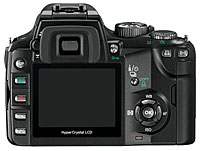 Storage is taken care of by CompactFlash Type II and xD Picture card memory card slots, with the camera capable of taking up to 4 RAW/TIFF/SHQ images in a row at 2.5 frames/second; with shooting continuing until the memory card is full at HQ quality.
Storage is taken care of by CompactFlash Type II and xD Picture card memory card slots, with the camera capable of taking up to 4 RAW/TIFF/SHQ images in a row at 2.5 frames/second; with shooting continuing until the memory card is full at HQ quality.